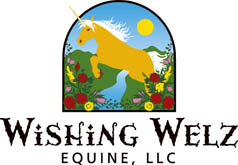My Past with Horses
by Yvonne Welz ©2000-2014
(Written in 2009, updated 2014)
I have spent well over 20 years now as an avid student of the equine. I expect to spend the rest of my life continuing that study. Every year brings me closer to my original goal: to find the great equestrian truths, wherever they might be. And what a long twisting journey it has been so far!
My greatest teachers have been my horses, most notably Shayla, Inty, Kendra, Belle and Swimmer. I started three from scratch all by myself, was the first person to sit upon their backs, and took them up through levels of classical training. Every horse taught me so much, and took me on a different journey.
I've had some great human guidance, as well. Early on in my riding education, I was lucky enough to have a long-time correspondence with the late author/trainer John Richard Young, who encouraged me to have courage and think outside the box. I didn't have much money, nor access to genuine riding schools or educated horses, but I did have tenacity and perseverance, and a natural feel for horses. With encouragement, I learned quickly, figured out techniques to stay safe, and rode A LOT. I also read dressage and equitation books voraciously, not only the great modern classics, but also many of the old, out-of-print major works that I was able to locate through interlibrary loans: books by Baucher, Chamberlin, Fillis, Beaudant, General de Carpentry, Steinbrecht and others.
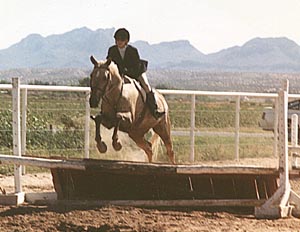
Yvonne and Shayla, Arab-cross mare, Hunter class 1989
I took my first formal “English” riding lessons during college in 1987. James, already my husband, and already a talented rider, soon joined me. I re-trained and showed my first horse (an ex-barrel racer) in hunter/jumper and combined training. James was the one who picked her out for me, and he took her jumping quite a bit further. She was a superhorse.
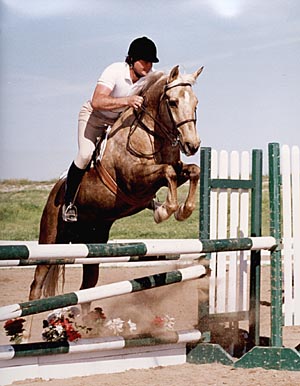
James and Shayla, Rated Jumper Show 1993
I took lessons and clinics with accomplished trainers, including a top hunter-jumper trainer, and a 3 day Olympic medalist eventing rider. Eventing led to dressage training... and soon I became quite intrigued with the sport of dressage. I spent many years taking even more clinics and lessons with FEI trainers, dressage judges, European riders, and other experts in dressage training. (Role models for sport dressage at that time were the likes of the great Reiner Klimke...)
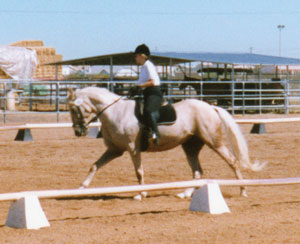
Yvonne and Shayla, Arab-cross mare, Dressage Show in mid 90's
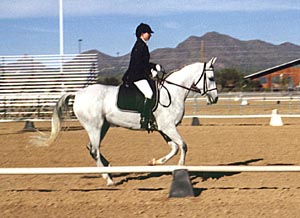
Yvonne and Inty, Lipizzan-cross mare, Dressage Show in mid 90's
I trained my next horse from scratch (purchased her unbroken) through successful showing up through Second Level dressage in the mid-90's. She was extremely talented, and we earned high scores. She won her very first rated dressage class with a score of 67%, and we were awarded the ADA Newcomers Trophy for 1993. During her several years of showing, she scored three 9's, and one score of "10" -- the latter being for a simple change of lead in a 2nd Level test. I was even told by a talented European trained rider that her gaits were good enough to compete on the national level.
However, that was not the direction I chose. I had started to become uncomfortable with some of the things I saw surrounding competitive riding (even way back then!). This led me to an exploration of French classical dressage in clinics with the renowned French expert Jean-Claude Racinet. With new skills obtained from my experiences with him, I advanced my dressage training tremendously, and even taught my horses to piaffe and Spanish walk. I trained my Lipizzan cross mare to an advanced level before soundness issues ended her riding career (and took me down the path of natural hoofcare, but that's a whole 'nother story!)
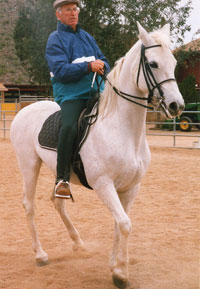
Jean-Claude Racinet riding my Inty during a clinic in the late 90's.
With the challenge of training my next horse, an aggressive and rambunctious yearling, I began to study various natural horsemanship methods that were then becoming widely popular. I saw great value in many of the techniques, and added them to my repertoire of skills. The philosophies of natural horsemanship were completely familiar to me, as I have always treated horses with the greatest of empathy and respect. I have never seen a great distance between my personal view of "dressage" and the philosophies of natural horsemanship.
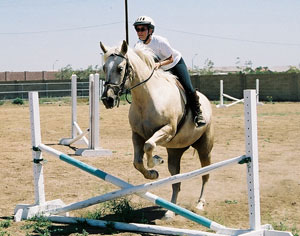
Yvonne riding 4 yo Paint mare Kendra, April 2003
Despite my previous disillusionment with showing, I was very adament about competing in the sport of dressage at that time, with the conviction that barefoot horses needed to make an appearance in show rings everywhere. That yearling turned into a huge, gorgeous stock horse mare, clearly unsuitable for competitive dressage, especially with the new heavy emphasis on warmblood-type gaits. Nonetheless, I took her into the competitive arena, where she was successful in her own right at Training Level, qualifying for a USDF Paint Horse award, placing 2nd in many classes at rated shows, and, finally winning First Place in a large class one memorable time. Rather than continue on swimming upstream in competitive dressage with her, I began to focus on my new, young, upcoming warmblood.
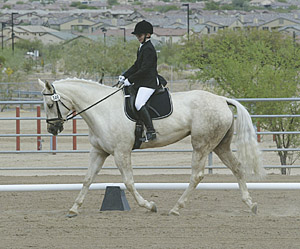
Yvonne riding Paint mare Kendra, Dressage Show Nov. 2004
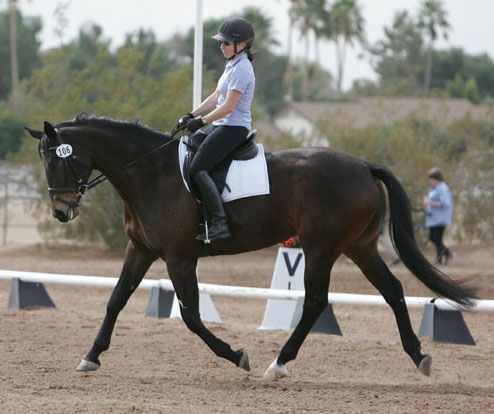
Yvonne riding warmblood mare Belle in a schooling show, January 2007
And so my young warmblood mare began her show career, and we went on to win the 2007 USDF All-Breeds Reserve Championship for RPSI Training Level, earning scores as high as 71%. However, just when everything seemed perfect, I began to notice the signs of stress, as resistance began to show up. Although I have always tried to be a gentle rider, I realized that the professionals I had been working with had encouraged me to use MUCH more coercion than I had realized. And no one realizes it -- this is simply the way that most of “dressage” training is currently practiced. It's a hard truth, and a bitter pill to swallow. The feelings and emotions of the horse are not considered; the horse has no opinion but must obey, with harsh application of the aids when they are resistant. I began to re-evaluate everything I had been doing. I had nothing but good intentions when I returned to competitive riding, but I realized that being around people with a less than optimal view of the horse was indeed compromising my principles.
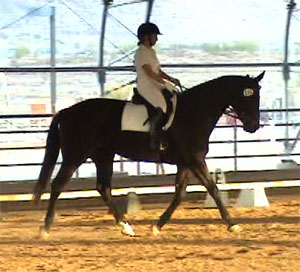
Yvonne riding Belle in First Level Test 1, Nov 2007
I turned my back on those professionals, and returned to my own path. By listening to my horse, instead of demanding her obedience, I was finally able to discover one source of her resistance: she was no longer comfortable in her saddle, and a new saddle greatly improved her attitude. However, hidden damage had been done, mentally and emotionally, that did take a few years to fully unravel. After that, I made a promise to myself: I will always put my horse first, even at the risk of offending people.
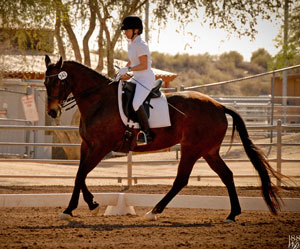
Yvonne riding Belle, 3rd level, Dressage Show March 2012
After that, I went on to take clinics with both natural horsemanship trainers, and classical German dressage trainers, while restudying the old school French/Baroque/Romanic dressage that I had been exposed to previously (finding inspiration through sources which emphasize lightness: Philippe Karl, Anja Beran, and Fritz Stahlecker). To further my skills, I embarked on more intensive studies of the horse's mind, emotion and natural behaviors. There is a way to combine the old schools of gentle, classical horsemanship (both German-Spanish Riding School and French-Cadre Noir) with the best theories of natural horsemanship. Good classical dressage is, and always was, natural; centuries ago, dressage was also called "natural riding." Classical dressage focuses on the natural gaits and natural movements of the horse, with harmonious communication between horse and human. Somewhere between it all, within the best of what is "natural" and what is "dressage," I find myself.
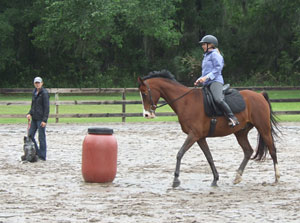
Yvonne riding schoolmaster Jedi with Karen Rohlf
(Dressage Naturally) in Florida, May 2013
Meanwhile, in March 2013, we added a new member to our family, and dubbed him the "Official Hoof Help Online App"! Swimmer was wild and crazy when we got him, but was ready for his first show 6 months later. He's a challenging yet fun horse; extremely intelligent and with tremendous natural talent. He can still be a real handful, though!!
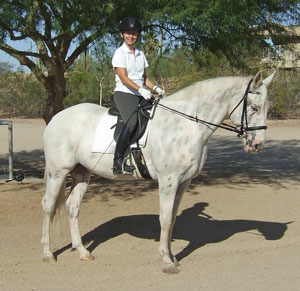
Yvonne riding Swimmer in his first show, September 2013
From 2012-2013, I participated in extensive clinics with Pierre Cousyn, double graduate of the National Equitation School in Saumur, France. In his simple, clear system of training, I found a perfect balance of French softness, German throughness, and total kindness. "Hands without legs, and legs without hands" remain a constant principle in my work. There was just one more element for me to discover...
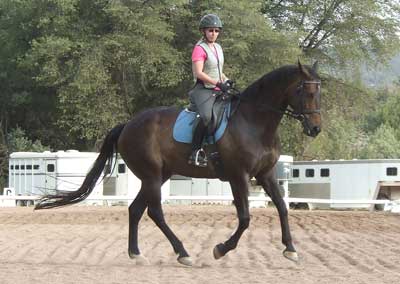
Yvonne riding Belle in Pierre Cousyn clinic in Payson, Arizona, June 2013
In December 2013, I discovered what I nicknamed the "bitless-bit" design of bitless bridles. This was a total game changer for me. The "feel" of this design of bitless bridle allows for the clear effective communication that is necessary for high school riding. Not only does it work as well as a bit, but I think it actually works BETTER. I now ride all my horses exclusively in this design - even Swimmer, the problem child! For more on this topic, please read My Bitless Story by Yvonne Welz and A Bitless-Bit for Dressage/High School Riders.
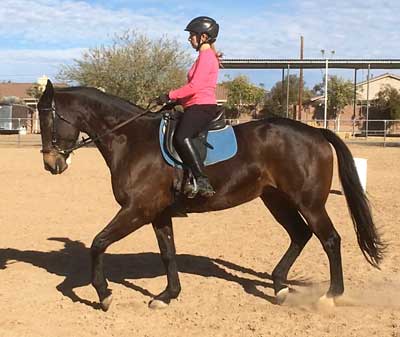
Yvonne riding Belle, Feb. 2014
James has been by my side all along the way, and he has schooled all of our horses over jumps and cross country. He is also talented at teaching exercises such as piaffe, passage, and Spanish Walk. We've always owned multiple horses so we could ride together, sharing them equally between us both. He is always my riding coach, as well.
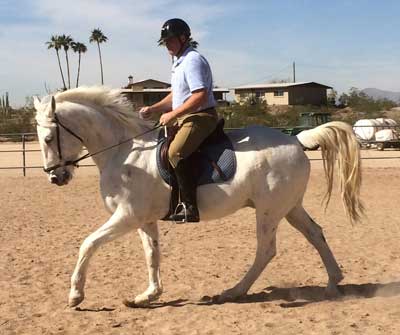
James riding Swimmer, Feb. 2014
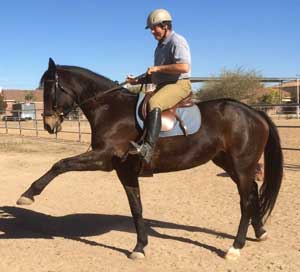
James riding Belle in Spanish Walk, Jan. 2014
I have never actually considered myself an amateur rider, although I have not been a true professional in past years, either. Once again, I am somewhere in the middle, not to be catagorized easily. From my early 20's on, I was determined to be a serious rider, to be professional (if professional meant serious!), and I nearly did take professional jobs several times... but in the end, backed out. I was afraid that training and working with horses full time for a JOB might ruin the passion that I felt for them. I was probably right! It would also have led me to compromise my principles. I have given part-time riding lessons frequently over the years, so therefore I was, according to USEF rules, technically a professional.
With our move to Wishing Welz Ranch in March 2014, we are now preparing to launch our innovative riding program. I will be offering lessons in classically correct schooling exercises that improve the horse both physically and mentally, with an emphasis NOT on show-ring ribbons, but instead on a deep and lasting connection with our horses. I can also help riders pick out the best bitless options for their horse, and teach them how to school correctly using the bitless tools. Our holistic program will include information on ground work, lunging, in-hand work, saddle fitting, correct horse care, hoof care, diet, and lifestyle to create the healthiest horses possible in our domestic world.
We plan to continue schooling our own horses with the goal of having a string of upper-level schoolmasters available for lessons, so that novice riders can experience the feeling of collected riding. Most instructors do not have highly-trained schoolmasters available for lessons, and it all comes down to this: they go lame. Upper level horses, if they are not yet lame, are too precious to allow others to ride them, because traditionally kept horses - GO LAME. Our horses will not. So in the future, we hope to have a large assortment of our very own barefoot, bitless, naturally-kept, schoolmaster high-school trained horses!
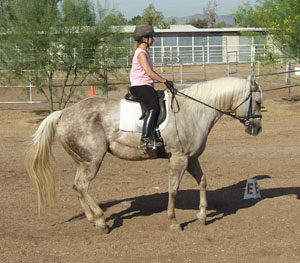
Yvonne and Kendra starting piaffe, September 2010
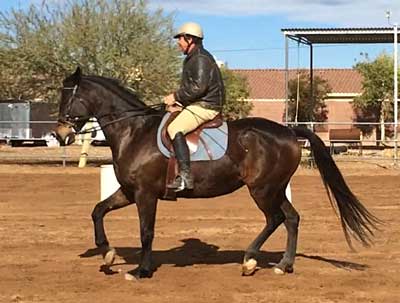
James riding Belle in passage, Decemeber 2013
My goal is to school all of my horses to the highest levels, while riding and training with the upmost empathy for the horse. That concern continues on to the horse's total well-being: natural, minimal stress lifestyle and healthy bare hooves. Everything is for the good of the horse, first and foremost. I break all the dressage "rules": My horses do not wear white leg wraps (or any other); they do not wear blankets; they are not body-clipped (they are never clipped anywhere for any cosmetic reason); they do not live full time in stalls; they are not turned out in isolated paddocks; they are not injected in any joints; and biggest of all, they don't even wear a bit! My horses (barefoot of course!) live out in herds, eating natural diets with free choice hay, minimal chemical exposure, and stress-free training. I am, effectively, a rebel within modern dressage -- seeking something better.
While I might continue to show in competitive dressage (or maybe not - I really do NOT approve of what is going on in those arenas right now, and besides, I will have to wait for them to legalize bitless!!!), that isn't really what is important. I am more interested in becoming the most skilled horseman I can be, and sharing that knowledge with others. I know that I am not alone in my perspective. (July 2014)
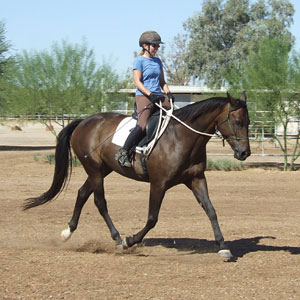
Yvonne riding Belle in a halter, August 2010
Click here for more Photos of My Horses
